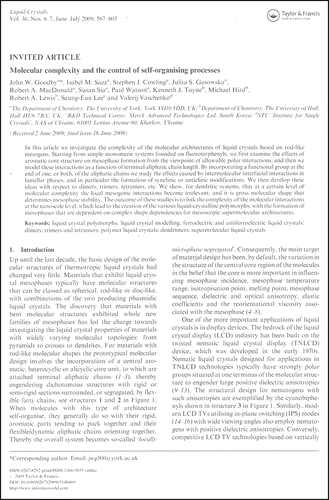Editorial: The 2009 Luckhurst-Samulski Prize
Last year saw the announcement of a major new award in the field of liquid crystals: The Luckhurst-Samulski Prize [Citation1]. The Prize was named after Geoffrey Luckhurst and Ed Samulski, not only in honour of their roles in founding the journal Liquid Crystals, but also for their outstanding contributions to liquid crystal science. The Prize is awarded for the best paper published each year in Liquid Crystals. A description of the Prize and its associated terms and conditions can be found on the Journal's website [Citation2].
In 2009, Liquid Crystals published 139 articles describing all areas of liquid crystal science and technology and from these the Selection Committee was given the unenviable task of choosing just one to become the inaugural Luckhurst-Samulski Prize-winner. In the first pass, five articles were selected which were all considered to be of the very highest quality, from which the winner was chosen. This was a tremendously difficult task and any one of these papers would have made an outstanding winner of the Prize.
I am delighted to announce that the 2009 Luckhurst-Samulski Prize has been awarded to the paper by John Goodby and his colleagues, entitled Molecular complexity and the control of self-organising processes [Citation3]. This conceptual paper provides excellent insight into understanding the relationships between intermolecular interactions and phase behaviour for a very wide range of molecular architectures and many of these ideas are clearly conveyed using a range of beautiful illustrations. The winners will be presented with their Prize at a ceremony to be held at ILCC 2010 in Krakow.
The remaining four articles were highly commended and these included, in chronological order, the paper by Frank Müller and Ralf Stannarius entitled Comparison of the rupture dynamics of smectic bubbles and soap bubbles [Citation4]. In this paper, the authors describe a beautiful and ingenious experimental study of the bursting of smectic bubbles and explain their striking results using a semi-qualitative theory.
The second of these papers was by William Thurmes and his colleagues, entitled Germanium liquid crystals, [Citation5] in which the authors synthesised and characterised the phase behaviour of a new type of liquid crystal. This paper provides the most comprehensive and detailed overview of this class of liquid crystal published to date and describes over 130 new germanium liquid crystals.
The next paper was by Patrick Oswald entitled Experimental study of the growth of cholesteric fingers subjected to an AC electric field and a temperature gradient [Citation6] which contains a combination of stunning photomicrographs, the description of complex macroscopic phenomena explained by simple fundamental physical principles and intriguing qualitative results that provide a demanding challenge for future theoretical work.
The last of these papers was by Nattaporn Chattham, Noel Clark and their colleagues, entitled de Gennes' triclinic smectics - not so far-fetched after all [Citation7]. In this paper, the authors present original experimental evidence for the existence of a triclinic smectic phase which had previously been theoretically predicted by de Gennes although he thought its actual existence rather unlikely.
I would like to thank everybody who published work in Liquid Crystals during 2009 and the selection committee for their hard work in selecting the 2009 Prize-winner. The 2010 competition is already well underway and John Goodby and his colleagues' paper has unquestionably set an extremely high standard for future winners of the Luckhurst-Samulski Prize to live up to!
References
- Imrie , C.T. 2009 . Liq. Cryst. , 36 : 565 – 566 .
- Liquid Crystals website. http://www.informaworld.com/tlct
- Goodby , J.W. , Saez , I.M. , Cowling , S.J. , Gasowska , J.S. , MacDonald , R.A. , Sia , S. , Watson , P. , Toyne , K.J. , Hird , M. , Lewis , R.A. , Lee , S.E. and Vaschenko , V. 2009 . Liq. Cryst. , 36 : 567 – 605 .
- Müller , F. and Stannarius , R. 2009 . Liq. Cryst. , 36 : 133 – 145 .
- Thurmes , W.N. , More , K.M. , Meadows , M.R. , O'Neill , M.B. , Vohra , R.T. and Ward , M.D. 2009 . Liq. Cryst. , 36 : 461 – 467 .
- Oswald , P. 2009 . Liq. Cryst. , 36 : 967 – 975 .
- Chattham , N. , Korblova , E. , Shao , R. , Walba , D.M. , Maclennan , J.E. and Clark , N.A. 2009 . Liq. Cryst. , 36 : 1309 – 1317 .
